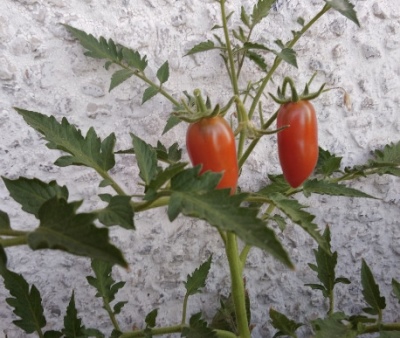
- Authors: Gavrish S.F., Kapustina R.N., Gladkov D.S., Volkov A.A., Semenova A.N., Artemyeva G.M., Filimonova Yu.A., Redichkina T.A. (OOO Research Institute of Vegetable Breeding, "Gavrish Breeding Firm" LLC)
- Year of approval: 2011
- Category: grade
- Growth type: determinant
- Appointment: fresh consumption, for whole fruit preservation
- Ripening period: early
- Ripening time, days: 80-90
- Growing conditions: for open ground, for balconies, pot culture
- Bush size: undersized
- Bush height, cm: up to 50
Miniature tomato varieties allow you to arrange a plantation in a small area and get a stable harvest. Tomato bushes A room surprise will not take up much space in the garden. With it, you can enjoy fresh and tasty tomatoes without having a large plot of land at your disposal.
Description of the variety
This variety has a determinate growth pattern. In addition to growing in open areas, tomatoes can be cultivated on balconies and loggias as a pot culture. The harvested fruits are great for canning whole fruits or eating in their natural form.
Low-growing bushes grow up to a maximum of 0.5 meters. They are compact and neat plants. Shoots are covered with medium-sized leaves. The color is deep green. In shape, the leaves resemble potato tops. In some regions, it is advisable to cultivate tomatoes indoors, getting a regular and high-quality harvest. When growing vegetables at home, both containers and flower pots are used. Due to their small size, the bushes do not need to be formed or tied up. Supports are used only when the shoots are covered with a large number of tomatoes. Under their weight, the branches begin to tilt towards the ground, and the contact of tomatoes with the ground is extremely undesirable.
The main qualities of the fruit
Light green tomatoes turn bright red as they ripen. Weight (on average) - 25 grams. Some copies are gaining up to 60 grams. The shape resembles a plum. Small tomatoes are slightly elongated. 5-6 fruits grow in one brush. The rind is glossy, smooth and very firm. The pulp is sugary in the cut, medium in density. A large number of seed chambers are hidden inside. Ripe tomatoes have good keeping quality. Tomatoes are perfect for fresh use or harvesting for the winter.
Taste characteristics
The taste of the harvest is noted as sweet with pleasant and sour notes. The gastronomic quality of the variety is high.
Ripening and fruiting
Ripening dates are early. They are 80-90 days long. Harvested from July to August.
Yield
The yield of the variety Indoor surprise depends on the growing conditions. The average is from 2 to 3 kilograms per bush. In indoor conditions, it is possible to collect up to one and a half kilograms, and in greenhouses or open ground, the yield is from 2.5 to 2.9 kilograms of vegetables. The maximum yield is 25 kilograms per square meter of plantation, provided that 10 bushes are placed on one square meter.
The timing of planting seedlings and planting in the ground
When growing a variety at home, sowing seedlings is carried out in early February. For open beds and unglazed balconies, the dates fall in the first half of March. Seedlings are transplanted into the ground from mid-May to early June. The exact timing should be calculated in such a way that by the time the seedlings are transferred to a new place, its age is 60-65 days.
For germination of seed, it is recommended to use wide, but shallow containers. They are filled with light soil with a high nutrient content.The acidity should be weak or neutral.
The work is carried out according to the following scheme:
the soil is moistened, and grains are laid out on its surface according to the 2x2 cm scheme;
the seeds are covered with a layer of soil 1-1.2 cm thick;
the container is covered with foil and taken to a dark but warm place for about 3-5 days;
as soon as the first shoots appear, the containers are transferred to a lighted place.
When growing seedlings in winter, it is necessary to consider additional light sources, such as phytolamps or fluorescent lamps. The total daylight hours should be at least 12 hours.
After the formation of the first pair of true leaves, the seedlings dive into separate containers and after another 60-65 days they are transplanted to a new place. For seating, containers from 2 to 5 liters are used. And also plants can be tied to supports, but this procedure is optional.

Growing tomato seedlings is an extremely important process, because it largely depends on whether the gardener can harvest at all. All aspects must be taken into account, from seedbed preparation to planting in the ground.
Landing scheme
The most common landing pattern is 30x30 centimeters. Due to its small size, a compacted planting is possible, in which up to 10 bushes are planted on a square meter of territory.

Growing and care
For further care of vegetables, you need to prepare warm and settled water. The Indoor Surprise variety prefers moderate but regular watering. And also loosening of the upper layers of the soil and weeding are required. Plants are fertilized 2 times a month. Choosing in favor of potassium-phosphorus formulations and ash-based fertilizing. The drug "Zdraven turbo" demonstrated high efficiency (15 grams of the substance is dissolved in 10 liters of water and consumed per square meter).
Top dressing is required when growing indoors. Of the ready-made formulations, Agrolife is used (one teaspoon per plant is enough) or Rost concentrate, one cap of which is diluted in two liters of water.




A plant needs different micronutrients at each stage of growth. All fertilizers can be divided into two groups: mineral and organic. Folk remedies are often used: iodine, yeast, bird droppings, eggshells.
It is important to observe the rate and period of feeding. This also applies to folk remedies and organic fertilizers.



























































































